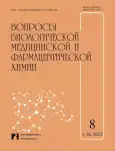Противовирусная активность биологически активной добавки на основе экстракта коры осины в отношении SARS-CoV-2 в опытах in vivo
- Авторы: Буркова В.Н.1, Сергун В.П.1, Иванов А.А.1, Пьянков О.В.2
-
Учреждения:
- ООО «Биолит»
- ФБУН ГНЦ ВБ «Вектор» Роспотребнадзора
- Выпуск: Том 26, № 8 (2023)
- Страницы: 44-50
- Раздел: Вопросы экспериментальной биологии и медицины
- URL: https://journals.eco-vector.com/1560-9596/article/view/568988
- DOI: https://doi.org/10.29296/25877313-2023-08-06
- ID: 568988
Цитировать
Полный текст
Аннотация
Цель работы – исследование противовирусной активности биологически активной добавки на основе экстракта коры осины в отношении вируса SARS-CoV-2 на модели сирийского хомяка, а также определение безопасной и эффективной дозы ее применения.
Материал и методы. Объектом исследования являлась биологически активная добавка к пище на основе экстракта коры осины (Populus tremula L.), содержащая концентрированный водный экстракт коры осины и дигидрокверцетин. В работе использовали штамм коронавируса, гомологичный раннему штамму человеческого SARS-CoV-2 – Wuhan-Hu-1, полученный из Государственной коллекции возбудителей вирусных инфекций и риккетсиозов ФБУН ГНЦ ВБ «Вектор» Роспотребнадзора. Исследование противовирусной активности проводили на сирийский хомяках (Mesocricetus auratus), полученных из питомника лабораторных животных ФБУН ГНЦ ВБ «Вектор» Роспотребнадзора, по следующим параметрам: количество РНК вируса (вирусная нагрузка) и инфекционный титр вируса в тканях легких и носовой полости.
Результаты. Установлено, что в указанных условиях проведения терапии эффективной безопасной суточной дозой препарата на основе экстракта коры осины является доза 2000 мг/кг; на четвертые сутки после заражения достоверно снижалась репликация вируса на слизистых носа инфицированных животных – в 3 раза и инфекционный титр вируса – в 43 раза. При повышении суточной дозы до 4000 мг/кг наблюдались признаки токсического эффекта. Определена минимальная терапевтическая суточная дозировка препарата на раннем сроке после заражения в отношении SARS-CoV-2 – в суточной дозе 250 мг/кг препарат достоверно снижал в тканях носовой полости вирусную нагрузку в 6,6 раза и инфекционный титр в 12,5 раза.
Выводы. В результате проведенных исследований in vivo показано, что биологически активная добавка к пище на основе экстракта коры осины обладает противовирусной активностью в отношении вируса SARS-CoV-2.
Ключевые слова
Полный текст
Об авторах
В. Н. Буркова
ООО «Биолит»
Email: infobiolit@yandex.ru
д.х.н., директор по науке и инновациям
Россия, г. ТомскВ. П. Сергун
ООО «Биолит»
Email: infobiolit@yandex.ru
к.х.н., директор
Россия, г. ТомскА. А. Иванов
ООО «Биолит»
Автор, ответственный за переписку.
Email: infobiolit@yandex.ru
к.х.н., руководитель отдела научных разработок
Россия, г. ТомскО. В. Пьянков
ФБУН ГНЦ ВБ «Вектор» Роспотребнадзора
Email: infobiolit@yandex.ru
к.б.н., зав. отделом «Коллекция микроорганизмов»
Россия, р.п. Кольцово, Новосибирская областьСписок литературы
- Zhu N., Zhang D., Wang W., Li X., Yang B., Song J., et al. A Novel Coronavirus from Patients with Pneumonia in China, 2019. The New England Journal of Medicine. 2020; 382(8): 727–733.
- World Health Organization. WHO Coronavirus (COVID-19) dashboard (Cited 01 Apr 2023). [Internet]. Available from: https://covid19.who.int.
- Tay M.Z., Poh C.M., Rénia L., et al. The trinity of COVID-19: immunity, inflammation and intervention. Nature Reviews Immunology. 2020; 20(6): 363–374.
- Guan W.J., Ni Z.Y., Hu Y., et al. Clinical Characteristics of Coronavirus Disease 2019 in China. The New England Journal of Medicine. 2020; 382: 1708–1720.
- Макашова В.В., Понежева Ж.Б., Омарова Х.Г. и др. Опыт применения Популина с дигидрокверцетином при новой коронавирусной инфекции. Эпидемиология и инфекционные болезни. Актуальные вопросы. 2022; 2: 77–82.
- Maisonnasse P., Guedj J., Behillil S., et al. Hydroxychloroquine use against SARS-CoV-2 infection in non-human primates. Nature. 2020; 585(7826): 584–587.
- Chan J.F.W., Zhang A.J., Yuan S., et al. Simulation of the clinical and pathological manifestations of coronavirus disease 2019 (COVID-19) in golden Syrian hamster model: Implications for disease pathogenesis and transmissibility. Clinical Infectious Diseases. 2020; 71(9): 2428–2446.
- Миронов А.Н. Руководство по доклиническим исследованиям лекарственных средств. М.: ФГБУ «НЦЭМСП». 2012. Т.1. 942 с.
- Reed L.J., Muench H. A simple method of estimating fifty percent endpoints. American Journal of Epidemiology. 1938; 27(3): 493–497.
- Абрашова Т.В., Гущин Я.А., Ковалева М.А. и др. Справочник. Физиологические, биохимические и биометрические показатели нормы экспериментальных животных. СПБ.: ЛЕМА. 2013. 116 с.
- Gruber A.D., Firsching T.C., Trimpert J., et al. Hamster models of COVID-19 pneumonia reviewed: How human can they be? Veterinary pathology. 2022; 59(4): 528–545.
Дополнительные файлы










